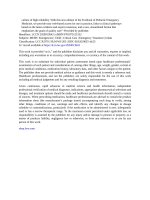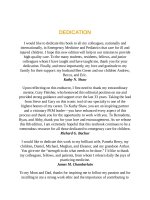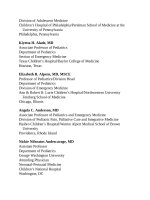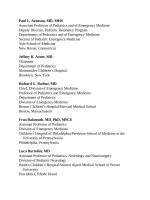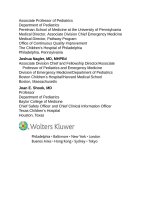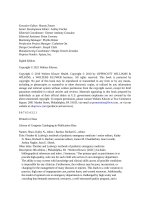Pediatric emergency medicine trisk 1129 1129
Bạn đang xem bản rút gọn của tài liệu. Xem và tải ngay bản đầy đủ của tài liệu tại đây (73.61 KB, 1 trang )
and the initiation of antibiotic therapy should the child worsen or if symptoms
persist beyond 48 to 72 hours. (See CHOP Clinical Pathway for
Evaluation/Treatment of Acute Otitis Media in Children 2 Months to 12 Years
Old; />.)
Most cases of AOM involve coinfection of a viral respiratory pathogen and
bacteria. The Eustachian tube dysfunction caused by the viral URI leads to
negative middle ear pressure, aspiration of contaminated upper airway secretions
into the middle ear cavity, and subsequent development of acute bacterial
infection. A viral prodrome followed by clinical worsening signals the onset of
AOM. AOM may also develop secondary infection of ongoing middle ear fluid
(OME).
Bacteria or bacterial DNA are found in middle ear fluid from almost all
patients with properly diagnosed AOM. The predominant bacterial pathogens are
nontypeable Haemophilus influenzae , Streptococcus pneumoniae , Moraxella
catarrhalis , and occasionally Streptococcus pyogenes. Since the advent of
immunization against S. pneumonia , H. influenza has become the most prevalent
bacterial pathogen recovered from middle ear aspirates. While some H. influenza
produce β-lactamase, the number of β-lactam–resistant strains is lower than
previously reported. High-dose amoxicillin (80 to 90 mg/kg/day) achieves middle
ear fluid concentrations that are greater than the minimum inhibitory
concentrations of all penicillin-sensitive and intermediately resistant S.
pneumonia serotypes, and many highly penicillin-resistant strains. Although all
M. catarrhalis produce β-lactamase, most experts believe AOM from M.
catarrhalis is mild, has a high spontaneous resolution rate, and is without
significant invasive potential, making coverage with a β-lactamase–resistant
antibiotic unnecessary in the majority of cases.
